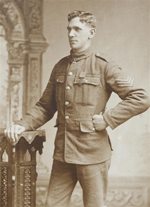John Carmichael (VC) facts for kids
Quick facts for kids
John Carmichael
VC MM
|
|
|---|---|
 |
|
| Born | 1 April 1893 Glenmavis, North Lanarkshire, Scotland |
| Died | 20 December 1977 (aged 84) Glenmavis, North Lanarkshire, Scotland |
| Buried |
New Monkland (Landward) Cemetery
|
| Allegiance | |
| Service/ |
|
| Rank | Sergeant |
| Unit | Royal Engineers Sherwood Foresters North Staffordshire Regiment |
| Battles/wars | World War I |
| Awards | Military Medal |
John Carmichael (born April 1, 1893 – died December 20, 1977) was a brave soldier from Scotland. He served in the British Army during World War I. John Carmichael received the Victoria Cross (VC), which is the highest award for bravery in the face of the enemy. It is given to soldiers from the United Kingdom and Commonwealth countries. He also received the Military Medal.
A Heroic Act of Bravery
In 1917, John Carmichael was a sergeant in the 9th Battalion of The North Staffordshire Regiment. He was 24 years old at the time. On September 8, 1917, Sergeant Carmichael was working with his men. They were digging a trench near a place called Hill 60 in Zwarteleen, Belgium.
Suddenly, they uncovered a dangerous grenade. The grenade had started to burn, meaning it could explode at any moment. Instead of just throwing it away, which might have hurt other soldiers working nearby, Sergeant Carmichael acted quickly. He yelled for his men to get away from the danger.
He then rushed forward and placed his metal helmet over the burning grenade. After that, he bravely stood on his helmet, covering the grenade with his own body. The grenade exploded right underneath him. The blast threw him out of the trench and caused him serious injuries. But because of his incredible bravery, no one else was hurt.
Life After the War
Sergeant Carmichael's injuries were very severe. He could not walk for three years after this heroic event. His act of self-sacrifice saved the lives of his fellow soldiers.
Where to See His Medal
Today, you can see John Carmichael's Victoria Cross medal. It is displayed at the Staffordshire Regiment Museum. This museum is located at Whittington Barracks in Lichfield, Staffordshire.

